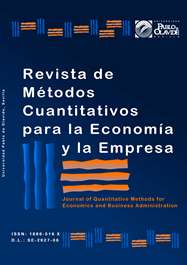Household characteristics and poverty: an application of support vector machines
DOI:
https://doi.org/10.46661/revmetodoscuanteconempresa.5377Keywords:
learning algorithm, household data, support vector machines, classification methods, povertyAbstract
The use of quantitative techniques for the classification of population segments is a critical phase to evaluate their conditions. This information will serve as input for planning strategies to alleviate poverty. In this article, we present a model of vector support machines. Consequently, a sample of families residing in Cartagena de Indias is segmented, based on certain economic and sociodemographic variables. Analytical results confirm that most important factors are employment status, accessibility to public services and familiar income. In addition, it is corroborated that neighborhood conditions and monetary transfers have a low discriminatory power.
Downloads
References
Arias, R., Sánchez, L., & Agüero, O. (2018). Impacto de la educación sobre la pobreza en regiones de planificación de Costa Rica. Revista Estudios del Desarrollo Social: Cuba y América Latina , 6(1), 1-21. https://doi.org/10.35622/j.rie.2019.01.009
Awad, M., & Khanna, R. (2015). Support Vector Machines for Classification: Theories, Concepts, and Applications for Engineers and System Designers. En M. Awad, & R. Khanna, Efficient Learning Machines (págs. 39-66). Apress, Berkeley, CA. https://doi.org/10.1007/978-1-4302-5990-9_3
Bastias, F., Cañadas, B., Sosa, V., & Moya, M. J. (2019). Explicaciones sobre el origen de la pobreza según área de formación profesional. Propósitos y Representaciones, 7(2), 107-120. https://doi.org/10.20511/pyr2019.v7n2.282
Bracco, J., Gasparini, L., & Tornarolli, L. (mayo de 2019). Explorando los Cambios de la Pobreza en Argentina: 2003-2015. Centro de Estudios Distributivos Laborales y Sociales. http://sedici.unlp.edu.ar/bitstream/handle/10915/75173/Documento_completo.pdf-PDFA.pdf?sequence=1&isAllowed=y https://doi.org/10.24215/18521649e009
Carmona, E. (11 de Julio de 2014). Tutorial sobre Máquinas de Vectores Soporte (SVM). Recuperado el 17 de Marzo de 2018 de http://www.ia.uned.es/~ejcarmona/publicaciones/[2013-Carmona]%20SVM.pdf
Cuentas, S., Peñabaena-Niebles, R., & Gar, E. (2017). Support vector machine in statistical process monitoring: a methodological and analytical review. The International Journal of Advanced Manufacturing Technology, 91(1-4), 485-500. https://doi.org/10.1007/s00170-016-9693-y
García, F. (2017). Responsabilidad y legitimidad en las transferencias monetarias condicionadas. Diánoia, 62(79), 193-216. https://doi.org/10.22201/iifs.18704913e.2017.79.1514
González, R., Barrientos, A., & Toa, M. (2017). Aplicación de las Máquinas de Soporte Vectorial (SVM) al diagnóstico clínico de la Enfermedad de Párkinson y el Temblor Esencial. Revista Iberoamericana de Automática e Informática Industrial, 14(4), 394-405. https://doi.org/10.1016/j.riai.2017.07.005
Jara, J., Giral, D., & Martínez, F. (2016). Implementación de algoritmos basados en máquinas de soporte vectorial (SVM) para sistemas eléctricos: revisión de tema. Revista Tecnura, 20(48), 149-170.
Jiménez, L., & Rengifo, P. (2010). Al interior de una máquina de soporte vectorial. Revista de Ciencias, 14, 73-85. https://doi.org/10.25100/rc.v14i0.655
L. Roos, L., Wall-Wieler, E., & Boram Lee, J. (2019). Poverty and Early Childhood Outcomes. Pediatrics, 143(6). https://doi.org/10.1542/peds.2018-3426
L.Harrison, J., & Montgomery, C. A. (2019). A spatial, simultaneous model of social capital and poverty. Journal of Behavioral and Experimental Economics, 78, 83-192. https://doi.org/10.1016/j.socec.2018.09.001
Markowetz, F., Edler, L., & Vingron, M. (2003). Support Vector Machines for Protein Fold Class Prediction. Biometrical Journal, 45(3), 377-389. https://doi.org/10.1002/bimj.200390019
Mohamoud, Y., Kirby, R., & Ehrenthal, D. P. (2019). Poverty, urban-rural classification and term infant mortality: a population-based multilevel analysis. BMC Pregnancy Childbirth, 19(40), 1-11. https://doi.org/10.1186/s12884-019-2190-1
Saidi, L., Fnaiech, F., & Ben Ali, J. (2015). Application of higher order spectral features and support vector machines for bearing faults classification. ISA Transactions, 54, 193-206. https://doi.org/10.1016/j.isatra.2014.08.007
Sánchez, N. (2015). Máquinas de soporte vectorial y redes neuronales artificiales en la predicción del movimiento USD/COP spot intradiario. ODEON(9), 113-172. https://doi.org/10.18601/17941113.n9.04
Sanogo, T. (2019). Does fiscal decentralization enhance citizens' access to public services and reduce poverty? Evidence from Côte d'Ivoire municipalities in a conflict setting. World Development, 113, 204-221. https://doi.org/10.1016/j.worlddev.2018.09.008
Suchacka, G., Skolimowska-Kulig, M., & Potempa, A. (2015). Classification Of E-Customer Sessions Based On Support Vector Machine. ECMS, 1-7. https://doi.org/10.7148/2015-0594
Wainer, J., & Cawley, G. (2017). Empirical Evaluation of Resampling Procedures for Optimising SVM Hyperparameters. Journal of Machine Learning Research, 18(15), 1-35.
Wen, Z., Li, B., Ramamohanarao, K., Chen, J., Chen, Y., & Zhang, R. (2017). Improving Efficiency of SVM k-Fold Cross-Validation by Alpha Seeding. AAAI, 2768-2774. https://doi.org/10.1609/aaai.v31i1.10785
Downloads
Published
How to Cite
Issue
Section
License
Copyright (c) 2022 Bruno de Jesús Rahmer, Hernando Garzón Saénz, Gustavo Ortiz Piedrahita, José Solana Garzón

This work is licensed under a Creative Commons Attribution-ShareAlike 4.0 International License.
Submission of manuscripts implies that the work described has not been published before (except in the form of an abstract or as part of thesis), that it is not under consideration for publication elsewhere and that, in case of acceptance, the authors agree to automatic transfer of the copyright to the Journal for its publication and dissemination. Authors retain the authors' right to use and share the article according to a personal or instutional use or scholarly sharing purposes; in addition, they retain patent, trademark and other intellectual property rights (including research data).
All the articles are published in the Journal under the Creative Commons license CC-BY-SA (Attribution-ShareAlike). It is allowed a commercial use of the work (always including the author attribution) and other derivative works, which must be released under the same license as the original work.
Up to Volume 21, this Journal has been licensing the articles under the Creative Commons license CC-BY-SA 3.0 ES. Starting from Volume 22, the Creative Commons license CC-BY-SA 4.0 is used.










